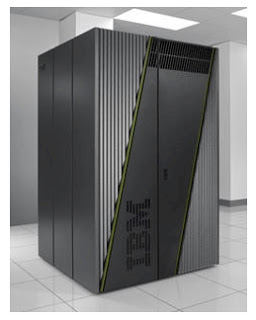The Mira machine will essentially be half of the Sequoia BlueGene / Q super that is going into Lawrence Livermore National Laboratory – another DOE lab that took the very first BlueGene/L super – next year. Sequoia will weigh in at 20.13 petaflops of aggregate, raw number-crunching power. Mira will have over 750,000 cores and more than 750TB of main memory to reach its 10-petaflops performance.
Bluegene / Q will have –
* 16-core Power A2 processors that are geared down and with special features for fast thread context switching
* The BlueGene / Q machine will put one of these Power A2 chips on a server node, with 8GB or 16GB of main memory per node (512MB to 1GB per core) running at 1.33GHz.
* The compute nodes have water blocks on the processors, main memory, and optical interconnects, and use water that is between 16 and 25 degrees Celsius (61 to 77 degrees Fahrenheit) to suck the heat out of the nodes. The water cools the optics first, then the compute nodes.
* the optical interconnect will be a 5D torus mesh with a bandwidth of 40GB/sec
Network World – By 2012, Mira will be one of three U.S. IBM systems capable of 10 petaflops or greater. IBM is also ramping up production of another supercomputer for the Energy Department’s Lawrence Livermore National Lab (LLNL), a 20-petaflop model to be called Sequoia. And it is also building the 10-petaflop Blue Waters system for the NSF-funded University of Illinois at Urbana-Champaign’s National Center for Supercomputing Applications.
If you liked this article, please give it a quick review on ycombinator or StumbleUpon. Thanks

Brian Wang is a Futurist Thought Leader and a popular Science blogger with 1 million readers per month. His blog Nextbigfuture.com is ranked #1 Science News Blog. It covers many disruptive technology and trends including Space, Robotics, Artificial Intelligence, Medicine, Anti-aging Biotechnology, and Nanotechnology.
Known for identifying cutting edge technologies, he is currently a Co-Founder of a startup and fundraiser for high potential early-stage companies. He is the Head of Research for Allocations for deep technology investments and an Angel Investor at Space Angels.
A frequent speaker at corporations, he has been a TEDx speaker, a Singularity University speaker and guest at numerous interviews for radio and podcasts. He is open to public speaking and advising engagements.


